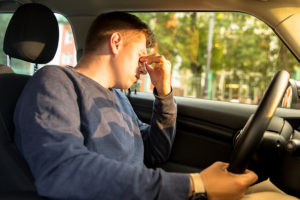
You cannot safely drive a motor vehicle when asleep. Unfortunately, around one in 25 adults self-report falling asleep behind the wheel within the past 30 days. Worse, driver fatigue causes an estimated 20 percent of fatal accidents on the road. Drowsy driving can have an incredible range of side effects for both those drivers and others who must share the road with them, but all too many people continue to get behind the wheel while struggling to stay awake potentially causing motor vehicle accidents.
Driver Fatigue: Defined
Driver fatigue occurs when a driver suffers tiredness or exhaustion while behind the wheel of a vehicle. Fatigue can occur for a range of reasons:
- Inadequate sleep the night before
- Too many hours behind the wheel
- Physical exertion
- Medication side effects
- Illness
Most drivers recognize signs of fatigue as they creep up: drooping eyelids, slowed breathing, and difficulty paying attention to the road. All too many drivers choose to stay behind the wheel anyway: they get in a hurry, need to reach work or school in spite of fatigue, or feel they have no other options.
How Fatigue Impairs Drivers
Fatigued drivers cannot stay as safe behind the wheel as alert divers. Fatigued drivers may:
- Fall asleep behind the wheel, causing them to lose control of the vehicle
- Struggle to keep attention on the road
- Suffer from decreased reflexes
- Fail to notice traffic signals
As a driver grows increasingly fatigued, it may substantially increase the risk of an accident. In many cases, fatigue acts on the body much like alcohol, causing a similar loss of control and attention.
Avoiding Fatigue While Driving
Ideally, you should avoid getting behind the wheel of a car while suffering from fatigue. Simply choosing not to drive while tired can help keep you and others safer. If you find yourself struggling to avoid driving while fatigued, try some of these strategies.
Move your bedtime back a little. If you suffer from constant fatigue, your bedtime could take the majority of the blame. Move your bedtime back by thirty minutes to an hour. Moving your bedtime back can also make it possible for you to get up earlier, which can give you more time to wake up before you have to get behind the wheel to head into work or school.
Take steps to keep yourself awake. While you should never drive while fatigued, if you start to feel tired in traffic, you can use several simple strategies to help keep yourself alert:
- Turn up the air conditioner. Cold air can help keep you alert; in winter, you might even consider rolling down the windows for a moment.
- Turn up your music. Choose bouncy, uplifting songs that will help increase your energy levels, rather than calming songs that will put you to sleep.
Take breaks on long drives. A long day behind the wheel can leave anyone struggling to stay awake. To help keep yourself safer, take plenty of breaks. Do not just stop at a rest stop or gas station, take care of the essentials, and hop right back in the vehicle if you find yourself suffering from fatigue. Instead, take some time to walk around the gas station or rest stop, if you can do so safely. Break up long drives with an overnight stop if needed, especially if you know you get drowsy after too many hours on the road.
Pull off the road, if you need to. Choose a safe location: a truck stop, a rest stop, or a well-lit parking lot. Nap for a few minutes. Sometimes, a 20-minute nap can offer enough refreshment that you feel better able to deal with the hazards on the road and get home safely.
Know your medications. Know how medications impact your body, including your ability to stay awake or your overall drowsiness level. If you know a medication causes you to get sleepy, avoid driving after taking that medication. When you start a new medication, do not simply jump behind the wheel immediately. Instead, give yourself time to see how you adapt to the new medication. Keep aware of any increasing side effects of your medications, too: even medications you have taken for years can develop new side effects over time.
When You Spot a Drowsy Driver
Sometimes, you may struggle to tell the difference between a drowsy driver and one under the influence of drugs or alcohol. Drowsy drivers may swerve around on the road, drive too fast or too slow, or ignore traffic signals. If you spot a drowsy driver, you can take several steps to help keep yourself safer.
- Get out of the way. If you feel you can pass safely, you can speed up and move around the drowsy driver. If you cannot safely get past the driver, reduce your rate of speed. You can even pull off the road, if needed, to help keep yourself out of the drowsy driver’s way.
- Call the police when you can safely make the call. Let the police know you spotted a driver behaving erratically or dangerously. They can dispatch a police car to pull over the driver or to identify potential hazards to overall safety. Try to note the car’s make and model or even license plate, if you can safely collect that information.
When you share the road with a drowsy driver, do not attempt to force that driver off the road or hit your horn to try to wake him up. In some cases, this could trigger road rage, which may pose a higher danger to you than the drowsy driver’s behavior.
If you suffer injuries in an accident due to a drowsy driver, you may need legal help to file your claim and seek compensation for your injuries. A compassionate auto accident attorney can listen to your story, answer your questions, and make sure you understand all of your options under the law.
